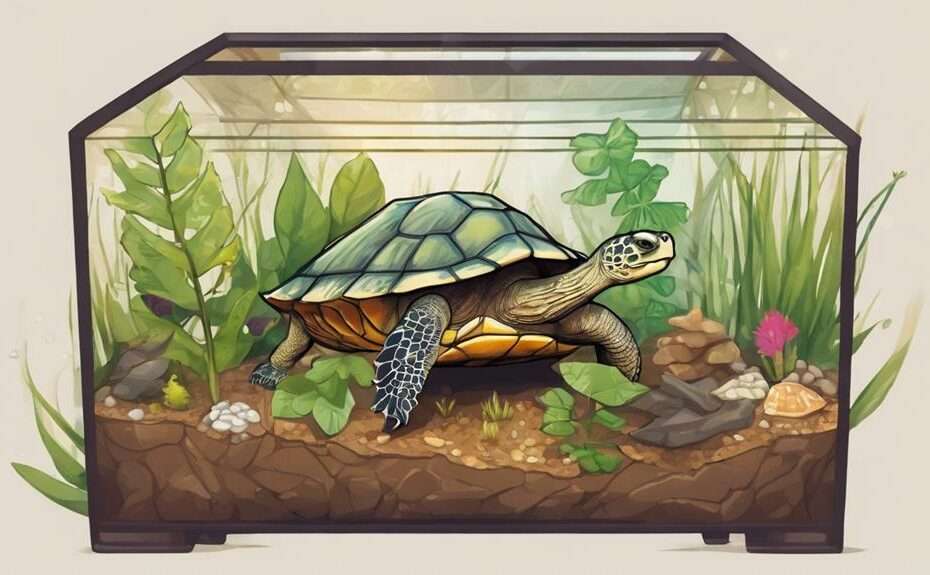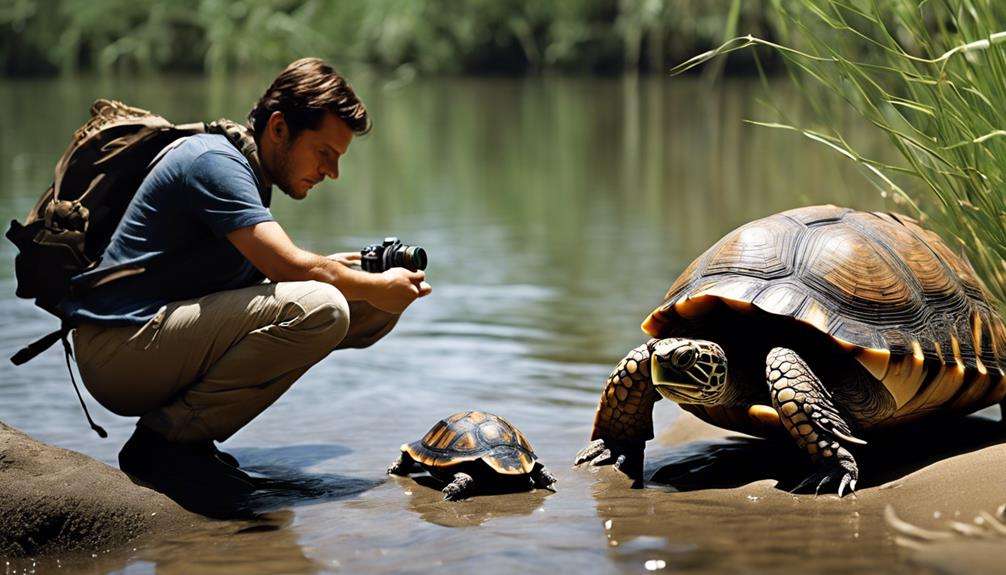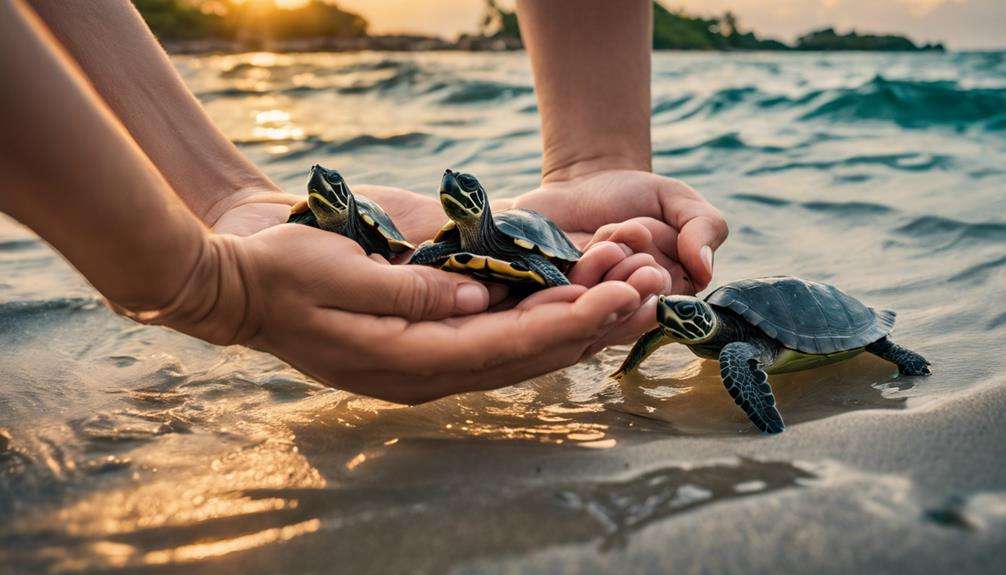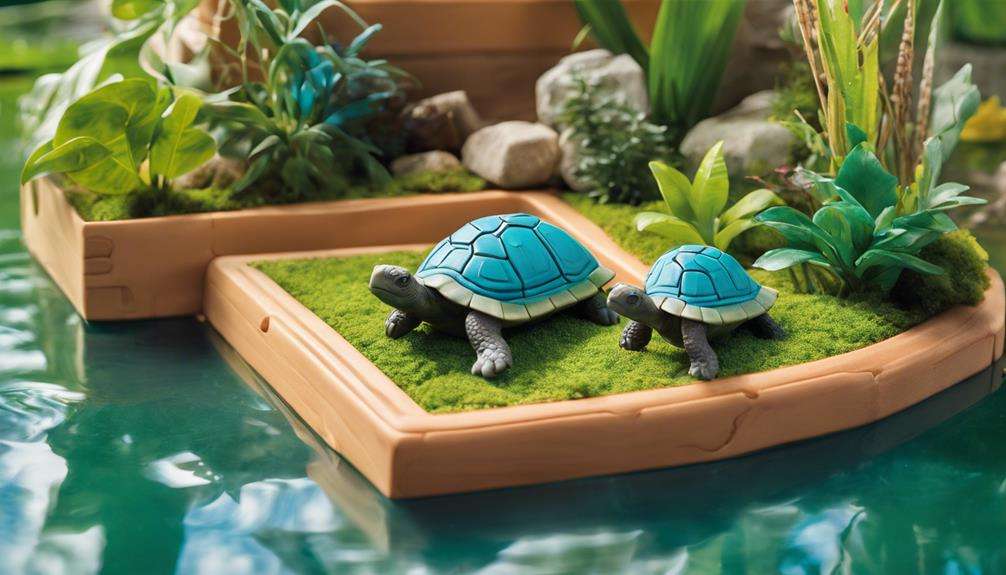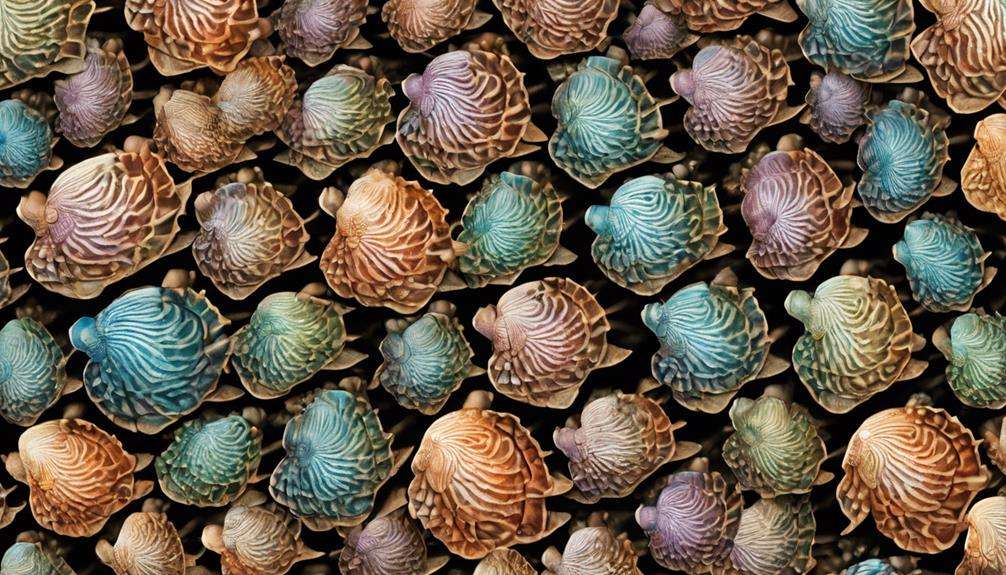If you've ever wondered about the unique care requirements of rare turtle breeds, this guide is a must-read.
Discover the intricate needs of these enchanting creatures and gain insights into their individual characteristics and habitats.
From the charming Mata Mata Turtle to the striking Chinese Golden Thread Turtle, each species offers a fascinating glimpse into the world of exotic pet care.
Explore the world of rare turtle breeds and reveal the secrets to providing exceptional care for these extraordinary reptiles.
Key Takeaways
- Rare turtle breeds require specific care due to their unique characteristics and behaviors.
- Providing proper water temperature and basking spots is crucial for their well-being.
- Consult experts for guidance on environmental setup and dietary needs.
- Understanding the individual requirements of each rare turtle breed is essential for their health and happiness.
Rare Turtle Breeds Overview
When considering rare turtle breeds, it's essential to understand their uniqueness and specific care requirements to provide them with a fulfilling and thriving environment. These unique species, like the intricate Diamondback Terrapin or the strikingly colored Painted Turtle, require specialized knowledge to guarantee their well-being. As an aquatic turtle enthusiast looking to explore the world of rare turtle breeds, you must be prepared for the distinctive care requirements these species entail.
Rare turtle breeds aren't commonly found in pet stores, and their specialized needs may pose challenges for inexperienced pet owners. From providing the right water temperature and quality for aquatic turtles to creating a basking spot that mimics their natural habitat, caring for these unique creatures demands attention to detail. Each rare turtle breed comes with its set of characteristics and behaviors that require a compassionate and knowledgeable approach to guarantee they thrive under your care. By understanding their specific care requirements, you can start on a rewarding journey as a dedicated rare turtle enthusiast.
Diamondback Terrapin Characteristics
Diamondback Terrapins exhibit distinctive diamond-shaped patterns on their shells, distinguishing them as a unique species among turtles. These patterns can vary in color and arrangement, making each terrapin visually distinct. Found in brackish coastal waters along the eastern and southern United States, diamondback terrapins possess specialized salt glands that allow them to thrive in environments where freshwater and saltwater mix.
Their diet is diverse, consisting of aquatic vegetation, mollusks, crustaceans, and small fish. The specialized salt glands in diamondback terrapins enable them to excrete excess salt, essential for maintaining a healthy salt balance in their bodies. Despite their remarkable adaptations, these turtles face significant threats. Habitat loss, pollution, and overharvesting have led to a decline in their populations, resulting in their classification as a threatened species.
Conservation efforts are essential to protect these unique turtles and guarantee their survival in their natural habitats. By understanding and appreciating the characteristics of diamondback terrapins, we can contribute to their conservation and well-being.
Malaysian Giant Pond Turtle Care
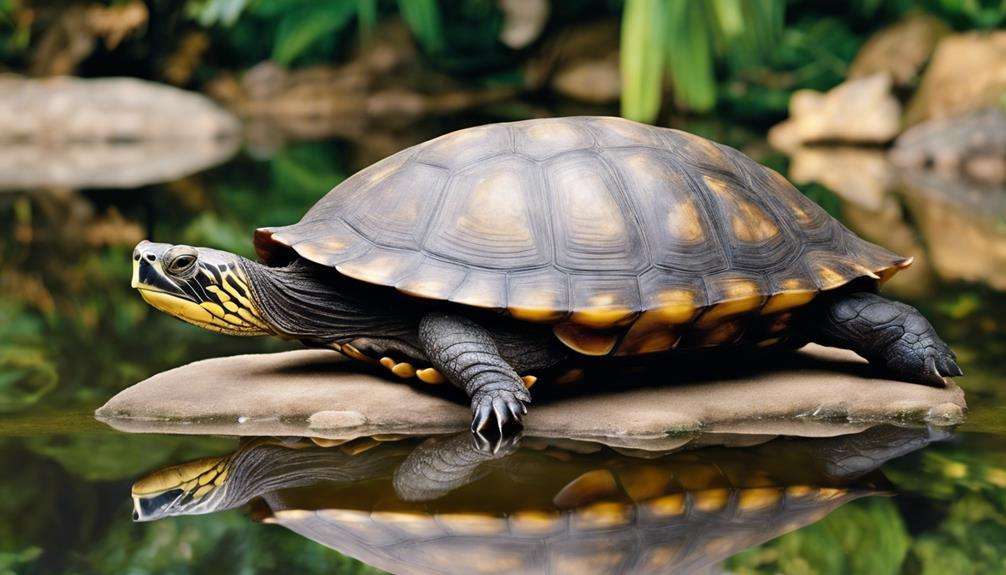
With their rare and unique characteristics, caring for Malaysian Giant Pond Turtles requires attention to specific environmental and dietary needs.
The Malaysian Giant Pond Turtle, a large freshwater turtle species native to Southeast Asia, can grow up to 18 inches in carapace length, making them one of the largest turtle species. To guarantee their well-being, provide a spacious aquatic habitat with clean, well-filtered water, basking areas, and UV lighting.
These turtles have a distinctive appearance, featuring a dark carapace and striking yellow spots or streaks on their head and limbs. Due to their rarity and specific care requirements, Malaysian Giant Pond Turtles aren't commonly found in the pet trade, making them a special addition to turtle collections.
Remember to consult with experienced reptile veterinarians or breeders for guidance on meeting the unique needs of Malaysian Giant Pond Turtles and providing them with a healthy and enriching environment.
Spiny Softshell Turtle Care Guide
For best health and well-being, Spiny Softshell Turtles require meticulous care and attention to their unique habitat and dietary needs. These turtles, known for their distinctive appearance with flat, leathery shells adorned with spiky projections and long snorkel-like noses, thrive in an aquatic lifestyle. As carnivorous reptiles, they feed on a diet consisting of fish, insects, crustaceans, and mollusks, using their sharp beaks to capture and consume prey.
To guarantee the proper care of Spiny Softshell Turtles in captivity, it's essential to provide them with a spacious tank that offers ample swimming room, basking areas where they can sunbathe, UV lighting to support their health, and a reliable filtration system to maintain water quality. Creating a habitat that mimics their natural environment is essential for their well-being. Additionally, offering a varied diet that meets their nutritional requirements is critical for their overall health and longevity. By providing the necessary elements for their care, you can help these unique turtles thrive in captivity.
Chinese Golden Thread Turtle Profile

The Chinese Golden Thread Turtle has specific habitat requirements important for its well-being. These include clean water, basking spots, and UV lighting.
Understanding their dietary needs is essential. These turtles are primarily herbivores that consume aquatic plants, algae, and some small invertebrates.
Providing proper health care, such as regular check-ups and a well-balanced diet, is important for the overall well-being of these unique turtles.
Habitat Requirements
To create a perfect habitat for your Chinese Golden Thread Turtle, make sure to provide a spacious aquatic environment with clean, filtered water and a designated basking spot for temperature regulation.
Chinese Golden Thread Turtles require a basking area where they can climb out of the water to dry off and regulate their body temperature effectively. Additionally, UVB lighting is essential to help these turtles metabolize calcium and maintain healthy shell growth.
Ensuring the water quality is vital for their well-being. By meeting these habitat requirements, you can create a comfortable and safe environment for your Chinese Golden Thread Turtle to thrive in captivity.
Diet and Feeding
Creating a well-rounded diet plan is key to ensuring the ultimate health and longevity of your Chinese Golden Thread Turtle. These herbivores require a diet rich in aquatic plants, leafy greens, and vegetables. Supplement their meals with commercial turtle pellets or protein sources like fish or shrimp to meet their dietary needs adequately.
Be careful not to overfeed them, as Chinese Golden Thread Turtles have a slower metabolism, making them prone to obesity and health issues. To support their shell and bone health, provide calcium and vitamin supplements regularly.
Monitor their diet closely, adjust portions as necessary, and offer a variety of foods to maintain balanced nutrition and promote overall well-being.
Health and Care
Ensuring the prime health and well-being of your Chinese Golden Thread Turtle involves meticulous attention to their unique care requirements and environment. These rare species, native to China, require specific care to thrive.
Providing a large, well-filtered tank with clean water and a basking area under UV lighting is essential. Chinese Golden Thread Turtles have a distinctive diet consisting of aquatic plants, insects, small fish, and commercial turtle pellets.
Regular monitoring of water quality, temperature, and humidity levels is vital for their health. Due to their rarity and specific care needs, these turtles are best suited for experienced turtle keepers who can create the proper environment.
Mata Mata Turtle Facts and Care
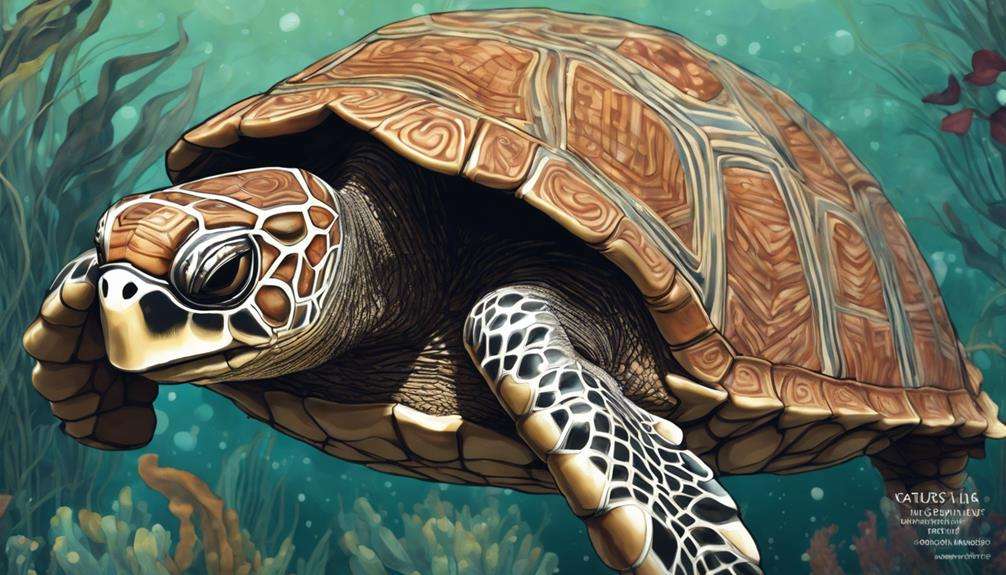
The remarkable Mata Mata turtle, native to South America, captivates with its unique appearance and specialized predatory behaviors. These turtles have a distinctive rough, algae-covered shell that resembles tree bark, aiding in their camouflage abilities. When submerged in water, Mata Matas remain motionless, blending seamlessly with their environment to ambush prey like fish and insects. Their long necks and wide mouths are perfectly adapted for their hunting style, making them efficient ambush predators.
To provide essential care for Mata Mata turtles in captivity, it is important to replicate their natural habitat. A spacious tank with ample water for swimming, basking areas for thermoregulation, and a varied diet comprising fish, insects, and vegetation are important for their well-being. Due to their specialized care needs and the effort required to meet them, Mata Mata turtles are considered a challenging yet rewarding species to keep as pets. Proper research and dedication are key to ensuring these fascinating turtles thrive in a captive environment.
Indian Flapshell Turtle Care Tips
When caring for Indian Flapshell Turtles, prioritize providing a habitat that mimics their natural aquatic environment to guarantee their well-being and health. Set up a spacious tank with both water and land areas, making sure the water is clean and filtered. Include aquatic plants for them to hide and explore, along with basking spots for them to regulate their body temperature. Maintain a water temperature between 75-86°F (24-30°C) and provide a UVB lamp for proper shell growth.
For their diet, offer a variety of foods such as aquatic plants, leafy greens, insects, small fish, and commercial turtle pellets. Remember to provide calcium supplements to support their shell development. Make sure fresh water is available at all times for drinking and swimming.
In addition to proper care at home, support conservation efforts for Indian Flapshell Turtles by spreading awareness about the threats they face in the wild. Encourage responsible pet ownership and avoid supporting the illegal trade of these unique turtles. By taking these care tips and conservation actions, you can contribute to the well-being of Indian Flapshell Turtles both in captivity and in their natural habitats.
Roti Island Snake-Necked Turtle Care
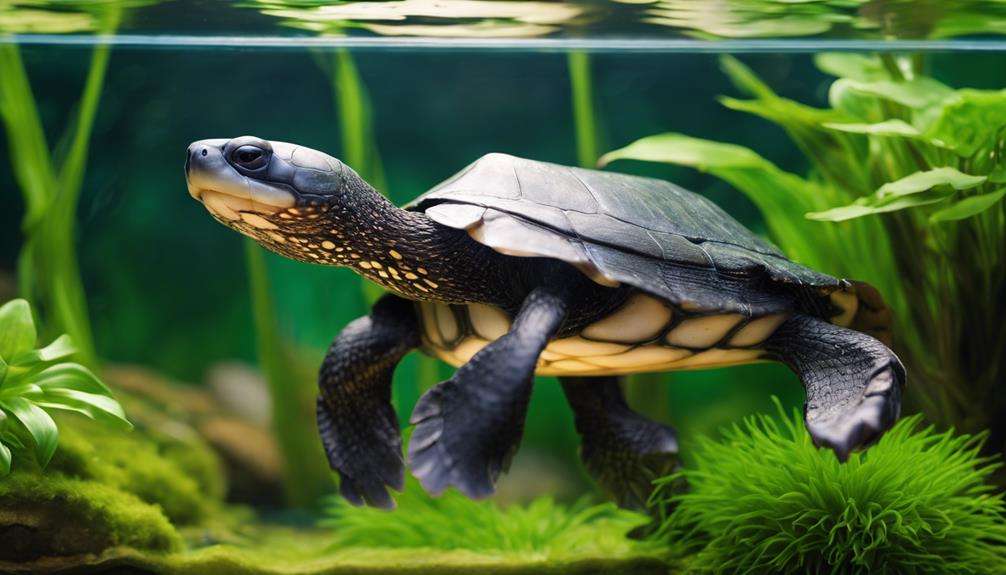
To provide excellent care for your Roti Island Snake-Necked Turtle, you must focus on creating a suitable habitat with ample space for swimming and basking, clean water, and proper UV lighting.
Their unique diet comprising aquatic plants, insects, and small fish should be carefully balanced to make sure their nutritional needs are met.
Regular health check-ups and maintaining good hygiene practices are essential to keep your turtle healthy and thriving.
Habitat Setup Tips
Ensuring a spacious and enriched habitat for your Roti Island Snake-Necked Turtle is essential for their well-being and overall health. To meet their needs, set up a spacious aquatic habitat with clean, filtered water that's deep enough for swimming.
Provide basking spots equipped with UVB lighting to support their shell and health. Mimic their natural environment by adding hiding spots and plants for security and enrichment.
It's critical to maintain a stable temperature range within the habitat, utilizing proper heating elements to meet the turtle's thermoregulation needs.
Feeding Requirements
Setting up a proper feeding routine for your Roti Island Snake-Necked Turtle is important for their overall health and nutrition. These carnivorous turtles thrive on a diet that includes a variety of foods. Make sure to offer a balanced mix of commercial turtle pellets for essential nutrients, earthworms, and shrimp for their protein requirements.
Additionally, incorporating occasional fruits and vegetables can provide crucial vitamins for their well-being. Young turtles may need daily feeding sessions, while adults can be fed every other day to maintain a healthy weight. Remember to monitor their food intake carefully to prevent issues like obesity or nutritional deficiencies.
Health and Hygiene
Maintaining the health and hygiene of your Roti Island Snake-Necked Turtle is essential for their overall well-being and longevity. Make sure a clean habitat by regularly changing the water and providing proper filtration to prevent health issues.
These turtles thrive when they've access to both water and land areas in their enclosure, mimicking their natural habitat. Offer a varied diet consisting of insects, fish, and vegetation to promote best health.
Monitor your turtle's shell condition, eyes, and behavior regularly to detect any health concerns early. By prioritizing cleanliness, a balanced diet, and consistent monitoring, you can help your Roti Island Snake-Necked Turtle lead a healthy and happy life.
Madagascar Big-Headed Turtle Care Essentials
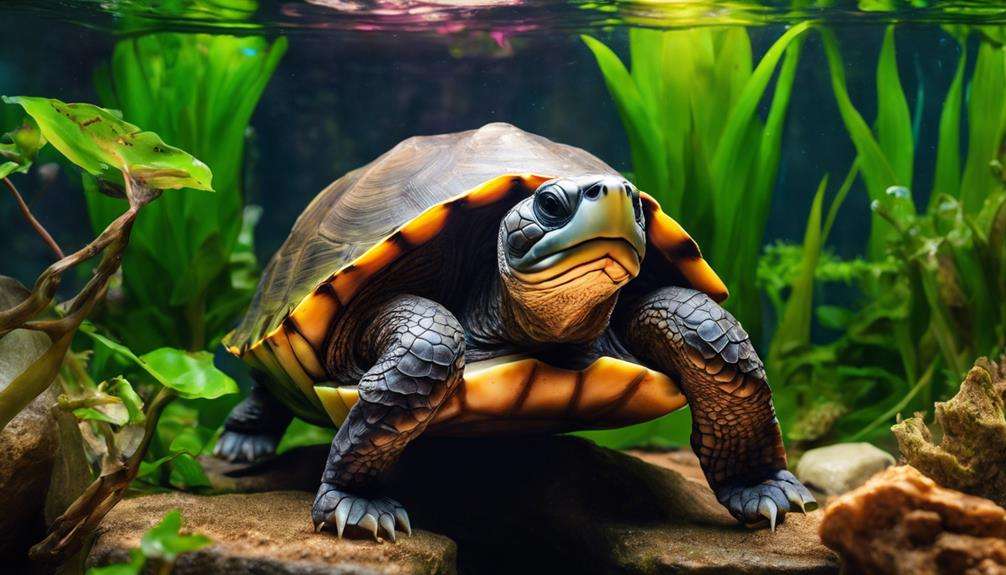
To properly care for Madagascar Big-Headed Turtles, attention to their unique dietary and habitat requirements is essential. As critically endangered reptiles endemic to Madagascar, these turtles possess a distinctive large head with a blunt snout, specifically designed for crushing and grinding food. Due to factors like habitat loss, hunting for food, and use in traditional medicine, their populations have greatly decreased in the wild. Conservation efforts are important in protecting the remaining Madagascar Big-Headed Turtles and raising awareness about their endangered status.
When it comes to caring for these turtles in captivity, replicating their natural habitat is crucial. Provide a spacious enclosure with both water and land areas, as they're semi-aquatic creatures. Maintain a warm and humid environment, ensuring that they've access to basking spots and clean water for swimming. Their diet should consist of a variety of aquatic plants, insects, and invertebrates to meet their nutritional needs. By participating in captive breeding programs and adhering to proper care guidelines, you contribute to the conservation of this unique and endangered species.
Frequently Asked Questions
What Is the Most Low Maintenance Pet Turtle?
When it comes to pet turtles, Painted Turtles are the ideal choice for you. They require easy upkeep, minimal care, and simple maintenance. With basic requirements and effortless care, they make a delightful and low-maintenance companion for any turtle enthusiast.
What Is the Best Breed of Turtle for a Pet?
For the best pet turtle, consider a breed like the red-eared slider. Their diet requires a mix of veggies and protein. Set up a warm habitat with a basking spot and UV light. Watch for shell rot and handle gently to build trust.
What Is the Most Affectionate Pet Turtle?
When choosing a pet turtle for affection, consider the Eastern Box Turtle. Their personable nature and interactive behavior make them a great companion. Bonding with these turtles through care and positive interactions can lead to a rewarding relationship.
What Is the Most Exotic Turtle?
The Pig-Nosed Turtle stands out as one of the rarest and most exotic turtle species, with its distinctive features and unusual habitats. Caring for such unique creatures involves understanding their special behaviors and diet.
Conclusion
As you reflect on the unique needs and characteristics of these rare turtle breeds, you may find yourself drawn to their enchanting personalities and intriguing care requirements. Remember, providing a loving and enriching environment for these special creatures isn't just a responsibility, but a rewarding journey of discovery and companionship.
Embrace the challenge, educate yourself, and watch as your bond with these remarkable turtles grows stronger each day. Enjoy the adventure of caring for these extraordinary animals!
